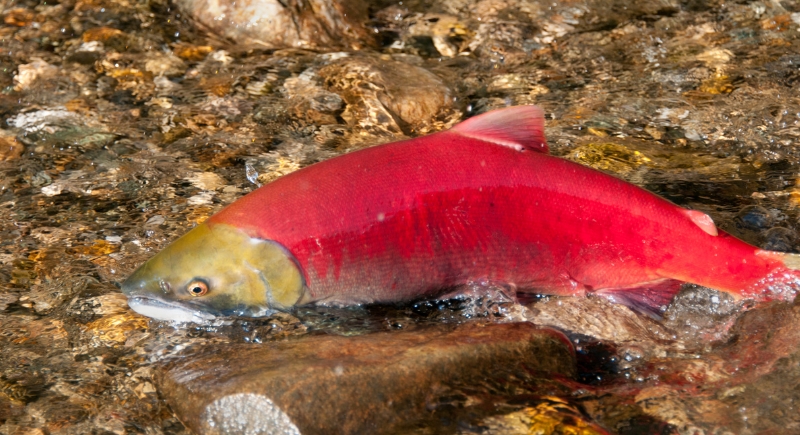The Real Reason Sockeye Salmon Have That Insanely Bright Red Color
Every summer, many rivers across Alaska appear as if they have caught fire. The water turns a deep, almost impossible red as if someone spilled paint across the current. Locals know what that color means, but for anyone seeing it for the first time, it’s hard to believe it’s real.
These rivers don’t glow because of reflections or tricks of light. The red comes from the salmon themselves as millions swim upstream to the cold waters where they were born. During this return, their bodies change from silver to bright scarlet. It’s the final stage of their life cycle, a transformation driven by instinct and biology that turns the river into a moving field of color.
The Secret Behind the Scarlet Hue

Image via Getty Images/Bird Images
In the ocean, sockeye salmon are easy to overlook. Their blue-green backs and silver sides blend perfectly into open water, which is really effective camouflage against predators. But when they begin their final journey back to their birthplace to spawn, their bodies change.
Hormonal signals trigger a shift that moves pigments stored deep in their flesh toward the surface of their skin. Over several weeks, their scales and skin turn bright red, and their heads shift to green. Male salmon develop hooked jaws and sharper teeth used for fighting over mates and territory.
That red color traces back to what they eat in the ocean. Sockeyes feed mainly on plankton, krill, and tiny crustaceans rich in carotenoids. These are the same natural pigments responsible for the orange in carrots and the pink in flamingos. The most significant, astaxanthin, collects in the salmon’s muscles and gives their meat its rich orange-red tone.
When the salmon are ready to spawn, these pigments move outward into their skin, transforming them into the vivid red fish that fill Alaska’s rivers each summer.
A Color With a Purpose
The bright red color isn’t simply decorative and serves an important biological function. In the clear waters where they spawn, color becomes communication. Males display intense red tones to signal vitality and strength, which helps them attract females and ward off rivals. A more vibrant shade often means a healthier fish with better reproductive fitness.
Females use their carotenoid stores differently. They direct some of these pigments into their eggs, which strengthens the embryos and improves survival rates. This division of pigment use between males and females helps ensure that the next generation starts strong.
Variations in color among spawning fish reflect differences in sex, maturity, and health rather than distinct reproductive “roles.” Even the slight differences in color among fish in a spawning stream reveal their sex, maturity, and health for the reproductive process.
Few natural events rival the sight of Alaska’s annual sockeye migration. In Bristol Bay, the largest sockeye run in the world, about 40 million salmon return each summer to complete their life cycle. These fish travel thousands of miles through the North Pacific before reaching the freshwater systems where they hatched.
Once they reenter freshwater, they stop eating altogether, relying solely on the energy reserves they built at sea. The fish provide food for bears, eagles, and even forests, as their bodies decompose and release nutrients into the water and soil. This migration supports entire ecosystems and local economies built around fishing and preservation.